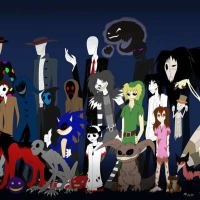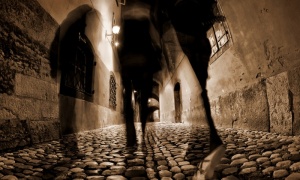Although it first appeared at the end of the eighties, Neil Gaiman is still best known as the creator of the wonderfully dark and imaginative Sandman comic series. Whilst this approbation is undoubtedly well-earned, it does something of a disservice to this multi-media writer’s other fine contributions to literature, film and TV (including the movie Stardust, the American Gods novel and some of the best episodes of shows ranging from Doctor Who to Babylon 5, not to mention his involvement in the formative stages of other landmark comics such as The Books of Magic and Spawn). I cannot think of another creative talent who has excelled in all of these areas as Gaiman has and this is best illustrated by Neverwhere – a story which has appeared in book, television and comic format.
 Basically, Neverwhere is another name for London Below, a place that most people could never even dream of that exists under the streets of the London we know. This is the city of the people who have fallen between the cracks – a place of monsters and saints, murderers and angels, knights in armour and pale girls in black velvet. Neverwhere is the story of a young businessman, Richard Mayhew, who is catapulted out of his humdrum existence by a single act of kindness and thrust into the eerily familiar yet utterly bizarre world of London Below, which bears a strange resemblance to the London Underground. Time and distances have no meaning here and the names of Tube stations acquire new relevance: the Earl resides at Earl’s Court, the black monks are in Blackfriars and Islington is an Angel. The characters are a memorable cast of Dickensian grotesques and lovelies: the frail but sassy Door, last scion of a noble house; the nightmarish assassins Croup and Vandemar; and the brilliant, untrustworthy tour de force that is the Marquis de Carabas.
Basically, Neverwhere is another name for London Below, a place that most people could never even dream of that exists under the streets of the London we know. This is the city of the people who have fallen between the cracks – a place of monsters and saints, murderers and angels, knights in armour and pale girls in black velvet. Neverwhere is the story of a young businessman, Richard Mayhew, who is catapulted out of his humdrum existence by a single act of kindness and thrust into the eerily familiar yet utterly bizarre world of London Below, which bears a strange resemblance to the London Underground. Time and distances have no meaning here and the names of Tube stations acquire new relevance: the Earl resides at Earl’s Court, the black monks are in Blackfriars and Islington is an Angel. The characters are a memorable cast of Dickensian grotesques and lovelies: the frail but sassy Door, last scion of a noble house; the nightmarish assassins Croup and Vandemar; and the brilliant, untrustworthy tour de force that is the Marquis de Carabas.
First to consider the Neverwhere novel. This is an absorbing read and newcomers to Gaiman’s prose will find his style fluid and engaging; he very much brings the picaresque characters to life while moving the various layers of intrigue along at a good pace. The version I read was called ‘the author’s preferred text’, which includes extra material such as an additional prologue and an interview with Neil Gaiman. This is also a very useful read to fill in the gaps for anyone left scratching their heads occasionally by the television series. However, this should not put anyone off watching Neverwhere on screen, which is an enjoyable experience in its own right. Instantly recognizable as a BBC sci-fi/fantasy production, on a par with Doctor Who and Red Dwarf, this has the same creaky sets and actors in latex costumes. Do not let this put you off, however, because, in the same vein as Hitch-Hikers Guide to the Galaxy and Blake’s Seven, it is the characters, storyline and plain imagination that really carry it off rather than the special effects. Hywel Bennett and Clive Russell are memorably scary as the villains of the piece but it is Paterson Joseph’s superbly eccentric depiction of the Marquis de Carabas that deserves most of the plaudits (such a missed opportunity that he was never cast as the first black actor to play Doctor Who…).
The real revelation of the Neverwhere franchise is also the least well-known in the form of the recently-released graphic novel. Having already experienced (and loved) both the book and the television series, I was not too sure about reading the comic and was surprised by just how good it was when I finally got around to it. Whilst Gaiman’s wonderfully twisted imagination is reined in by the limitations of prose in the novel and a nineties budget in the TV adaptation, in the comic it is given full rein. The Lady Door appears to be much more aristocratic in ink, like a female circus ring-leader crossed with Marie Antoinette, while De Carabas seems more like Lewis Carroll’s Cheshire Cat than a human being. Be warned: there are many dark, frightening moments in all the versions of Neverwhere but it is in the comic that they are brought to life most terrifyingly and this is therefore most certainly not one for the squeamish. In this way it recalls the best of Gaiman’s work in the Sandman series and for this reason I’m inclined to think that the graphic novel is the closest thing to his original conception of Neverwhere (at least until there is a big-budget movie version…).
By way of conclusion, there is currently no definitive ‘best’ version of Neverwhere and I’d just recommend that you seek it out in whatever format you feel most comfortable with to begin with. I have no doubt, however, that once experienced in one medium you will, like me, want to revisit the world of London Below again and again.
















I first got into Neil with his Sandman work while studying Sequential Art in college. He’s very talented, a lot of deep subject matter. I’ll be sure to check out Neverwhere when I get some free time!